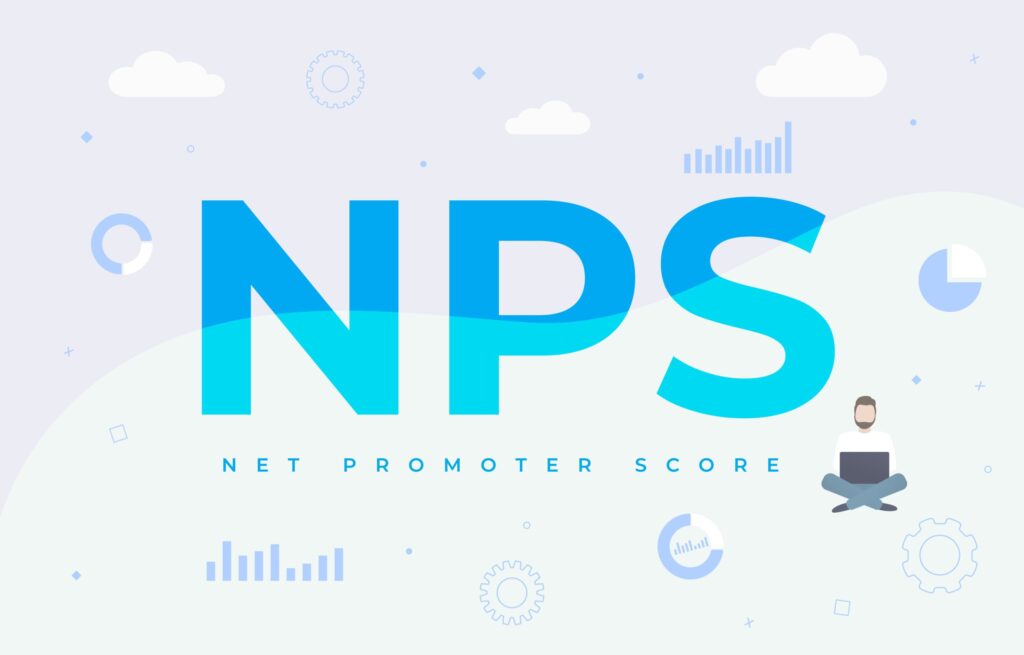What Is Net Promoter Score or NPS?


Table of Contents
Key Takeaways:
- Measure customer experience with Net Promotor Scores.
- Use NPS to build brand loyalty and improve CX.
- Understand relationships, transactions, and competition with NPS.
- Learn how to accurately calculate and read NPS scores.
- Tracking NPS benchmarks over time will show if your changes are working.
What Is Net Promoter Score or NPS?
In 2003, Net Promoter Score® (NPS) was introduced to the business world as a simple way to measure the customer experience (CX).
Its originator claimed that responses to one consumer survey question, above all others, demonstrated a strong correlation with customer loyalty and revenue growth. This question was the basis for the Net Promoter Score system.
Its billing as the “ultimate question” or “the one number you need to grow” tapped into businesses’ desire for “big picture” metrics that could quantify fuzzy, hard-to-nail-down dimensions like customer experience.
Net Promoter Score Defined
At the most basic level, the Net Promoter Score is nothing more than a metric – a tool for measuring the customer experience . But what is remarkable is that a metric – a number, after all – has generated so much passion both for and against it. Many have pointed out its shortcomings, even as it has become the go-to measure across most industries for predicting customer loyalty and the business growth that accompanies it.
Defining Net Promoter Score is most easily done by showing how it actually works in practice.
As originally conceived and promoted, NPS was based on a customer’s answer to a single question: “How likely is it that you would recommend [brand or company] to a friend or colleague?”
The simplicity of the response was both its biggest selling point and its biggest drawback.
There are three types of Net Promoter Scores: relationship-based, experience-based, and competitive benchmark. They are distinguished by the source used to calculate NPS and the purpose to which the score is put.
Why Is NPS Important
The importance of NPS in most service industries today is attributable to a number of different factors:
Near-Universal Buy-in
Net Promoter Score has value because so many companies have bought into it, adopting NPS as a standard unit of measure.
The appeal of “the one number you need to grow” made NPS the new religion in marketing departments everywhere. If there has ever been such a thing as a “Hot Metric,” NPS was it.
It offers companies a handy benchmark – a single data point by which to compare themselves to their competitors and to businesses in other industries. And once companies invest in a new system, changing course is no easy task, even when the results are difficult to interpret or turn into action.
This peer-driven adoption is a major reason why NPS has become a standard business KPI.
It Invites Further CX Investigation
Even though NPS by itself may not provide guidance for action to improve performance, just asking the “Would you recommend…?” question lends itself to follow-up questions that attempt to get at the underlying reasons for the customer’s response.
The logical next step to the NPS question is to find out WHY that customer would or would not recommend the business to others. By drilling down to identify the drivers of the customer’s response, the company gets a much better idea of changes needed to make the experience one the customer would recommend.
It Quantifies the Customer Mindset
Every business owner wants to understand what builds customer loyalty, but expressing that emotional connection and its various changes as a number may seem counter-intuitive.
As the saying goes, “if it can be measured, it can be improved,” or at least it can be improved if the action taken is based on reliable intel.
NPS gives businesses a quantifiable, comparable benchmark for tracking the opportunities that come with having your most loyal customers become your biggest advocates.


The Three Types of Net Promoter Scores
Relationship
In relationship-based NPS, a company regularly asks a sample of their own customers how likely they would be to recommend the company to friends or colleagues, and why.
The feedback captured from this approach provides an overall assessment of the health of the customer relationship. It is a more comprehensive assessment of how a customer feels about their relationship with a business or a brand.
When analyzed properly, it delivers insight to functional teams so they can make decisions and take action to improve service, sales, product design, pricing, or other policies.
Experience
The experience-based approach to NPS surveying asks for feedback from customers after certain experiences or transactions.
For example, a survey may be sent to a customer following the opening of an account or a simple teller transaction. This type of feedback focuses on understanding the influence that certain moments or touchpoints have on customer loyalty.
Experiential NPS can be useful for pinpointing friction at different points along the customer journey, which may arise from a business’s various products, processes, people, and channels.
Competitive Benchmark
This type of NPS is different from relationship and experience-based NPS in that it is based on feedback not only from a business’ own customers but also from its competitors’ customers.
Competitive benchmark NPS provides an objective basis for comparing one company’s feedback to the feedback its competitors generate.
Competitive benchmark NPS tells a company how it is doing, not just against direct competitors but against every competing alternative in the marketplace. That knowledge helps business executives identify major threats and opportunities, as well as determine strategic priorities.
Transactional vs Relational NPS
Transactional or experience NPS measures customer loyalty and experience after a specific interaction or transaction.
Relational or relationship NPS offers a bigger-picture view of the customer relationship. It measures how customers feel about your company as a whole, independent of any recent encounters.
With appropriate follow-up, both relationship and experience NPS surveys can contribute to continuous improvement of the customer experience.
These methodologies diagnose problems, identify friction, and provide opportunities for organizational learning.


How Do You Calculate a Net Promoter Score?
Calculating NPS starts with a single question: “How likely is it that you would recommend [brand or company] to a friend or colleague?”
Then the customer responds by indicating on an 11-point (0 to 10) scale the degree of his or her likelihood to provide a recommendation.
A score of 0 indicates the customer is extremely unlikely to recommend the business, while a score of 10 indicates the customer is extremely likely to recommend them.
Along this 0 to 10 scale, scores are divided into three groups: Promoters, Passives (or Neutrals), and Detractors.
Promoters
Promoters are those who respond to the NPS question with a score of 9 or 10.
These are your biggest champions, the advocates most likely to display loyalty through repeat business with you, and to generate new business by telling others about their experience with you.
The more Promoters you have, the greater the likelihood that your business will achieve growth.
Passives
Passives, or Neutrals, are respondents who give a score of 7 or 8 on the NPS question. They are mainly satisfied but unenthusiastic customers. They just aren’t particularly motivated to talk about you to others, either positively or negatively.
They could easily be lured to a different company that makes a better offer.
The objective is to convert these Passives into Promoters by consistently delivering superior customer service.
Detractors
Detractors are dissatisfied customers.
What’s worse, they are unafraid or even eager to tell others why they are unhappy with you.
They may be actively looking for a different service provider, but they can do a lot of damage to your reputation and brand value before they leave!
NPS is calculated simply by subtracting the percentage of customers who are Detractors from the percentage of customers who are Promoters.
Note that Passives or Neutrals are assigned a value of 0 and are not included in the NPS calculation.
The resulting score – expressed as a raw number, not a percentage – has generally been regarded, and marketed, as a predictor of customer loyalty and future revenue growth.
How to Read a Net Promoter Score
Reading a Net Promoter Score requires a special kind of skill, if you want to get optimal value out of it.
By itself, NPS is just a number. If you’re like most businesses, you have plenty of numbers. The trick is getting insights that you can actually use out of the data to get you to your objectives.
So you need to be able to interpret what your NPS – and your customers – are telling you. NPS is useful as a big-picture diagnostic of where friction may be impeding the customer journey. It can bring attention to problems related to touchpoints involving products, processes, people or channels. With proper follow-up, an NPS survey can raise awareness of problems impacting the customer experience, and it can direct you to the best means to alleviate them.
What Is Considered a Good NPS Score?
Most executives just want to cut to the chase, and learn if their NPS is “good.”
In an absolute sense, on the Net Promoter scale that ranges from -100 to 100, anything above a 0 could be considered good.
Realistically, because you are comparing your NPS against the competition, a score between 25 and 50 is good, and between 50 and 80 is excellent. If you score about 80, you’re the best of the best.
It’s worth noting that a perfect score of 100 means that every survey respondent would recommend you – a score that nobody has achieved. But rather than thinking in absolutes, it is of greater benefit to you to think in relative terms.
Your Net Promoter Score benchmark compared against the standard, or average, for your industry helps you understand what “good” should look like for your business.
What Is an Average NPS Score?
To avoid apples-to-oranges comparisons among businesses, average NPS is usually broken down by industry.
For example, in 2021 the average NPS for banking was 31. This is the benchmark that can serve as an external point of comparison.
Benchmarking against other businesses in your industry primarily indicates how you are doing against the competition. It can also suggest what level of effort you need to pull away from the crowd. Average, after all, should not be the goal of any business.
What Is a Bad NPS Score?
It might seem obvious that, if you’re getting a negative NPS, you have a lot of work to do.
A bad NPS results when you have a higher number of Detractors than Promoters.
In practical terms, scores less than 25 should be considered bad. Your customers are not happy with your brand, and customer satisfaction levels are extremely low. Your customers are just waiting for the next option to come along before they bolt to the competition.
You need to convert your Detractors into Promoters and energize some Passives into Promoters.


Creating an NPS Survey
NPS surveys are fairly easy to create, as they generally revolve around the single “Would you recommend…?” question.
The appeal of the survey arises from its simplicity, but you can make it as complex as you need to get the information you want.
Just be aware that the longer you make the survey, the greater the likelihood that the respondent will abandon it before completion.
They may not even begin the survey if they can see from the start how much time it might take to complete!
Types of Surveys
There are two main options for deploying your NPS survey, depending on the target you want to reach.
Website Surveys
As one approach to collecting your NPS data, you can create an on-page survey that shows up directly on your website pages. This gives anyone the ability to offer feedback.
The advantage is that you have a greater pool of respondents.
The disadvantage is that you don’t have control over the targets of your surveys; for example, if you wanted to collect data from a certain demographic or based on a specific type of transaction.
There is value, however, just in visibly showing that you are openly inviting – and presumably acting on – feedback from your customers and potential customers.
Email Surveys
Email is the most common method for deploying an NPS survey.
You create the template containing the NPS question, as well as any follow-up questions to discover more about the reasons for the respondent’s given score.
Surveys of particular experiences (like a teller transaction or a loan application process) rely on email surveys to reach the necessary individuals.
This method has the advantage of giving you control over who receives the survey. The risk is that some recipients might succumb to “survey fatigue” if they receive too many surveys over a certain period of time.
Also, an emailed survey is susceptible to being overlooked due to the overwhelming number people receive on a daily basis.
In your email inviting the recipient to complete the survey, be sure to tell them it is short and won’t take up too much of their time. Also, tell them explicitly that you will listen to what they have to say and that their feedback makes an actual difference in the service they and other customers receive.
Finally, be sure to thank them for their time and feedback!
Core NPS Questions
When you’re talking about core NPS questions, you always start with just one: “How likely is it that you would recommend [brand or company] to a friend or colleague?”
There are variations on the question, but best not to stray too much from the standard format.
Not only have decades of research been devoted to the NPS question, but changing it up too much may weaken its validity and effectiveness as a competitive benchmark.
Now that you’ve asked the main core question, it doesn’t end there.
You need to dissect the respondent’s answer to that question to get information you can actually use to direct change.
So the next logical question is one that gets at the drivers of the respondent’s answer, something along the lines of, “Why did you give that score?”
You can present either a limited menu of options for the respondent to choose from (usually with an “other” option because you can’t include everything in the menu), or just offer an open comment box and let the respondent explain in his or her own words.
Another way to ask the driver/follow-up question is to tailor it based on whether the respondent was a Promoter, Detractor or Passive.
For example, someone who answers the NPS question with a 10 would be a Promoter and could be asked a question like, “What did you love most about our product/service?”
By contrast, someone giving an NPS of 4 would be a Detractor and might receive a question like, “What was disappointing or frustrating about your experience with us?”
Demographic NPS Questions
Questions asking for demographic information about a respondent are often treated as a standard component of any survey. But be careful not to ask unnecessary questions.
Each additional question you ask makes it more likely the respondent will abandon it.
Finding out about the respondent’s age, gender, income, etc. can be useful in segmenting your analysis, but in many cases that information is already captured in other systems, like a CRM or customer database.
Asking too many, or the wrong kinds, of demographics questions can also seem intrusive to some respondents.


Net Promoter Score Tracking
The effectiveness of Net Promoter Score lies in benchmarking and tracking the impact of your improvement efforts over time.
Capturing a single NPS survey result won’t give you much insight into what is actually changing within your organization.
A single score is a snapshot that tells you where you stand at the moment. Without more context, it doesn’t reveal if you’re headed in the right direction.
You can do a one-time comparison to your competitors’ scores, but that snapshot has limited value for informing action. Moreover, your customers care less about how well you do against your competitors than about how well you take care of them.
You can’t manage what you don’t measure, and you can’t improve what you don’t track.
A single CX score like NPS is too generalized and unfocused to serve as a guide for improving frontline execution.
By tracking your NPS benchmarks over time, the trends show whether the changes you’ve implemented are working.
It will give you a snapshot of customer sentiment toward you and can be useful in identifying friction in the customer journey. Still, it is insufficient, by itself, to drive business growth arising from customer loyalty.
NPS may be helpful in signaling that corrective action is needed, but it will not tell you what that action needs to be.
Closing
A fundamental purpose of any organizational measurement is to improve performance.
In the case of customer experience measurement, the objective is to strengthen customer relationships as a catalyst for revenue growth and profitability.
You need more than a diagnostic of customer sentiment to change the culture.
It’s not enough for your customers to say they will or will not recommend you, they do or don’t like you, they are encountering friction, etc.
Strong customer relationships are the foundation of your CX culture, and they are the most important contributor to your growth and long-term success.
So it is crucial that the analytics you are relying on can contribute to the process of building these relationships.
NPS can be a part of a comprehensive customer satisfaction program, but it is important to understand its limitations in improving frontline execution, even when done correctly.
A holistic approach that incorporates multiple customer satisfaction metrics and directly impacts employee skills is your best bet to drive real change. Without such an approach, you risk missing or wasting information crucial to achieving your objectives around the customer journey and your ultimate business goals.
A comprehensive solution will give you this actionable information by showing WHY things are changing instead of just pointing out that they are changing.
Then it will show you what needs to change to excel in the execution of your strategy.
Now you should have a better understanding of how NPS works to move an organization toward predictable outcomes.
If you are looking for a comprehensive survey solution that can optimize your NPS and other CX metrics, we’d welcome the opportunity to show you what our Insight Builder survey platform can do for you!
Have More Questions? Reach Out to Our Team Of Experts
Net Promoter®, NPS®, NPS Prism®, and the NPS-related emoticons are registered trademarks of Bain & Company, Inc., Satmetrix Systems, Inc., and Fred Reichheld.















